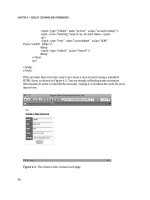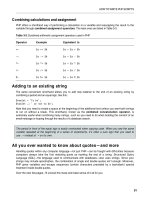Web to py enterprise web framework - p 8 doc
Bạn đang xem bản rút gọn của tài liệu. Xem và tải ngay bản đầy đủ của tài liệu tại đây (517.52 KB, 10 trang )
FORM SELF-SUBMISSION 55
1 def first():
2 form = FORM(INPUT(_name='visitor_name', requires=IS_NOT_EMPTY()),
3 INPUT(_type='submit'))
4 if form.accepts(request.vars, session):
5 session.visitor_name = form.vars.visitor_name
6 redirect(URL(r=request, f='second'))
7 return dict(form=form)
where we are saying that the FORM tag contains two INPUT tags. The
attributes of the input tags are specified by the named arguments starting with
underscore. The requires argument is not a tag attribute (because it does not
start by underscore) but it sets a validator for the value of visitor
name.
The form object can be easily serialized in HTML by embedding it in the
"default/first.html" view.
1 {{extend 'layout.html'}}
2 What is your name?
3 {{=form}}
The form.accepts method applies the validators. If the self-submitted form
passes validation, it stores the variables in the session and redirects as before.
If the form does not pass validation, error messages are inserted in the form
and shown to the user, shown below:
In the next section we will show how forms can be generated automatically
from a model.
56 OVERVIEW
3.6 An Image Blog
Here, as another example, we wish to create a web application that allows the
administrator to post images and give them a name, and allows the visitors of
the web site to view the images and submit comments.
As before, create the new application from the site page in admin and
navigate to the [EDIT] page:
We start by creating a model, a representation of the persistent data in the
application (the images to upload, their names, and the comments). First,
you need to create/edit a model file which, for lack of imagination, we call
"db.py". Models and controllers must have a .py extension since they are
Python code. If the extension is not provided, it is appended by web2py.
Views instead have a .html extension since they mainly contain HTML code.
Edit the "db.py" file by clicking the corresponding "edit" button:
AN IMAGE BLOG 57
and enter the following:
1 db = DAL("sqlite://storage.db")
2
3 db.define_table('image',
4 Field('title'),
5 Field('file', 'upload'))
6
7 db.define_table('comment',
8 Field('image_id', db.image),
9 Field('author'),
10 Field('email'),
11 Field('body', 'text'))
12
13 db.image.title.requires = [IS_NOT_EMPTY(),
14 IS_NOT_IN_DB(db, db.image.title)]
15
16 db.comment.image_id.requires = IS_IN_DB(db, db.image.id, '%(title)s')
17 db.comment.author.requires = IS_NOT_EMPTY()
18 db.comment.email.requires = IS_EMAIL()
19 db.comment.body.requires = IS_NOT_EMPTY()
20
21 db.comment.image_id.writable = db.comment.image_id.readable = False
Let’s analyze this line by line.
• Line 1 defines a global variable called db that represents the database
connection. In this case it is a connection to a SQLite database stored
58 OVERVIEW
in the file "applications/images/databases/storage.db". In the SQLite
case, if the database does not exist, it is created.
You can change the name of the file, as well as the name of the global
variable db, but it is convenient to give them the same name, to make it
easy to remember.
• Lines 3-5 define a table "image". define
table is a method of the db
object. The first argument, "image", is the name of the table we are
defining. The other arguments are the fields belonging to that table.
This table has a field called "title", a field called "file", and a field called
"id" that serves as the table primary key ("id" is not explicitly declared
because all tables have an id field by default). The field "title" is a
string, and the field "file" is of type "upload". "upload" is a special type
of field used by the web2py Data Abstraction Layer (DAL) to store
the names of uploaded files. web2py knows how to upload files (via
streaming if they are large), rename them safely, and store them.
When a table is defined, web2py takes one of several possible actions:
a) if the table does not exist, the table is created; b) if the table exists and
does not correspond to the definition, the table is altered accordingly,
and if a field has a different type, web2py tries to convert its contents;
c) if the table exists and corresponds to the definition, web2py does
nothing.
This behavior is called "migration". In web2py migrations are auto-
matic, but can be disabled for each table by passing migrate=False as
the last argument of define
table.
• Lines 7-11 define another table called "comment". A comment has an
"author", an "email" (we intend to store the email address of the author
of the comment), a "body" of type "text" (we intend to use it to store
the actual comment posted by the author), and an "image
id" field of
type reference that points to db.image via the "id" field.
• In lines 13-14 db.image.title represents the field "title" of table "im-
age". The attribute requires allows you to set requirements/constraints
that will be enforced by web2py forms. Here we require that the "ti-
tle" is not empty (IS
NOT EMPTY()) and that it is unique (IS NOT IN DB(db,
db.image.title)). The objects representing these constraints are called
validators. Multiple validators can be grouped in a list. Validators
are executed in the order they appear. IS
NOT IN DB(a, b) is a special
validator that checks that the value of a field b for a new record is not
already in a.
AN IMAGE BLOG 59
• Line 16 requires that the field "image
id" of table "comment" is in
db.image.id. As far as the database is concerned, we had already
declared this when we defined the table "comment". Now we are
explicitly telling the model that this condition should be enforced by
web2py, too, at the form processing level when a new comment is
posted, so that invalid values do not propagate from input forms to the
database. We also require that the "image id" be represented by the
"title", ’%(title)s’, of the corresponding record.
• Line 18 indicates that the field "image
id" of table "comment" should
not be shown in forms, writable=False and not even in readonly forms,
readable=False.
The meaning of the validators in lines 17-19 should be obvious.
Once a model is defined, if there are no errors, web2py creates an appli-
cation administration interface to manage the database. You access it via the
"database administration" link in the [EDIT] page or directly:
1 http://127.0.0.1:8000/images/appadmin
Here is a screenshot of the appadmin interface:
This interface is coded in the controller called "appadmin.py" and the
corresponding view "appadmin.html". From now on, we will refer to this
interface simply as appadmin. It allows the administrator to insert new
database records, edit and delete existing records, browse tables, and perform
database joins.
The first time appadmin is accessed, the model is executed and the tables
are created. The web2py DAL translates Python code into SQL statements
that are specific to the selected database back-end (SQLite in this example).
60 OVERVIEW
You can see the generated SQL from the [EDIT] page by clicking on the
"sql.log" link under "models". Notice that the link is not present until the
tables have been created.
If you were to edit the model and access appadmin again, web2py would
generate SQL to alter the existing tables. The generated SQL is logged into
"sql.log".
Now go back to appadmin and try to insert a new image record:
web2py has translated the db.image.file "upload" field into an upload
form for the file. When the form is submitted and an image file is uploaded,
the file is renamed in a secure way that preserves the extension, it is saved
with the new name under the application "uploads" folder, and the new name
AN IMAGE BLOG 61
is stored in the db.image.file field. This process is designed to prevent
directory traversal attacks.
When you click on a table name in appadmin, web2py performs a select
of all records on the current table, identified by the DAL query
1 db.image.id > 0
and renders the result.
You can select a different set of records by editing the SQL query and
pressing "apply".
To edit or delete a single record, click on the record id number.
62 OVERVIEW
Because of the IS IN DB validator, the reference field "image id" is rendered
by a drop-down menu. The items in the drop-down are stored as keys
(db.image.id), but are represented by their db.image.title, as specified by
the validator.
Validators are powerful objects that know how to represent fields, filter
field values, generate errors, and format values extracted from the field.
The following figure shows what happens when you submit a form that
does not pass validation:
AN IMAGE BLOG 63
The same forms that are automatically generated by appadmin can also
be generated programmatically via the SQLFORM helper and embedded in user
applications. These forms are CSS-friendly, and can be customized.
Every application has its own appadmin; therefore, appadmin itself can
be modified without affecting other applications.
So far, the application knows how to store data, and we have seen how
to access the database via appadmin. Access to appadmin is restricted to
the administrator, and it is not intended as a production web interface for the
application; hence the next part of this walk-through. Specifically we want
to create:
• An "index" page that lists all available images sorted by title and links
to detail pages for the images.
• A "show/[id]" page that shows the visitor the requested image and
allows the visitor to view and post comments.
• A "download/[name]" action to download uploaded images.
This is represented schematically here:
index
//
show/[id]
img
//
download/[name]
64 OVERVIEW
Go back to the [EDIT] page and edit the "default.py" controller, replacing
its contents with the following:
1 def index():
2 images = db().select(db.image.ALL, orderby=db.image.title)
3 return dict(images=images)
This action returns a dictionary. The keys of the items in the dictionary are
interpreted as variables passed to the view associated to the action. If there
is no view, the action is rendered by the "generic.html" view that is provided
with every web2py application.
The index action performs a select of all fields (db.image.ALL) from table
image, ordered by db.image.title. The result of the select is a Rows object
containing the records. Assign it to a local variable called images returned by
the action to the view. images is iterable andits elements are the selected rows.
Foreachrowthecolumnscanbeaccessed asdictionaries: images[0][’title’]
or equivalently as images[0].title.
Ifyoudonotwriteaview,thedictionaryisrendered by "views/generic.html"
and a call to the index action would look like this:
You have not created a view for this action yet, so web2py renders the set
of records in plain tabular form.
Proceed to create a view for the index action. Return to admin, edit
"default/index.html" and replace its content with the following:
1 {{extend 'layout.html'}}
2 <h1>Current Images</h1>
3 <ul>
4 {{for image in images:}}
5 {{=LI(A(image.title, _href=URL(r=request, f="show", args=image.id)))
}}
6 {{pass}}
7 </ul>









